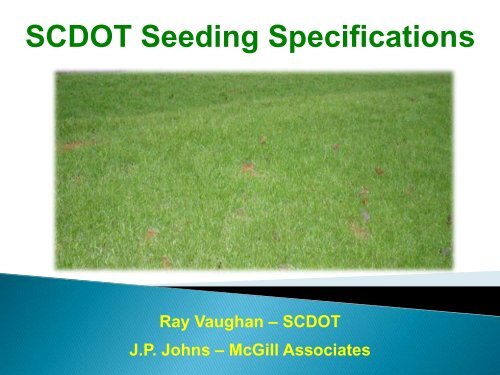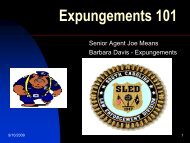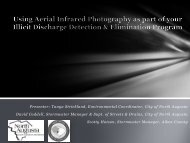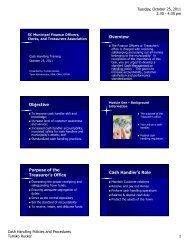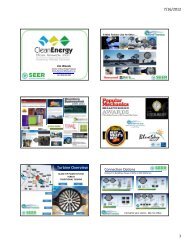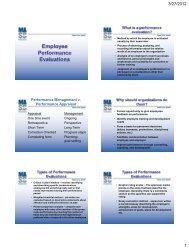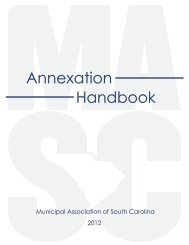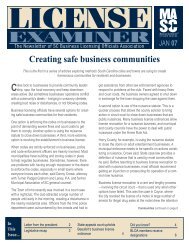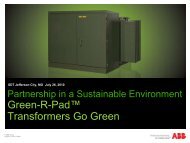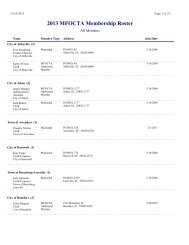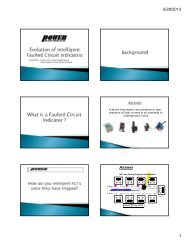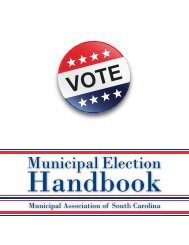SCDOT Seeding Specifications - Municipal Association of South ...
SCDOT Seeding Specifications - Municipal Association of South ...
SCDOT Seeding Specifications - Municipal Association of South ...
You also want an ePaper? Increase the reach of your titles
YUMPU automatically turns print PDFs into web optimized ePapers that Google loves.
<strong>SCDOT</strong> <strong>Seeding</strong> <strong>Specifications</strong><br />
Ray Vaughan – <strong>SCDOT</strong><br />
J.P. Johns – McGill Associates
SCASM 2009
Select seed from<br />
◦ Table 1 Perennials<br />
◦ Table 2 Annuals<br />
Lower State<br />
Upper State<br />
If seed in tables are not available,<br />
Contractor may select most<br />
practicable alternative seed<br />
available as substitute.<br />
The Contractor must submit data to<br />
the RCE showing substitute seed is<br />
appropriate for specific application.<br />
SCASM 2009
Select a minimum <strong>of</strong> 2 seed types from Table 1 for all permanent<br />
cover (specific application, time <strong>of</strong> year and availability <strong>of</strong> seed).<br />
Minimum 1 seed type must be a turf-type species.<br />
Contractor may add permanent cover nurse crop from Table 2.<br />
Exceptions for selecting minimum <strong>of</strong> 2 permanent cover species<br />
from Table 1 are:<br />
◦ Medians in Upper State and Lower State utilize a minimum <strong>of</strong> 1 turf-type<br />
species from Table 1 and 1 permanent cover nurse crop from Table 2.<br />
◦ Shoulder work in the Lower State utilize a minimum <strong>of</strong> 1 turf-type species<br />
from Table 1 and Contractor may add permanent cover nurse crop from<br />
Table 2.<br />
SCASM 2009
COMMON NAME 5<br />
TURF-TYPE GRASSES (SELECT ONE)<br />
BOTANICAL<br />
NAME<br />
TABLE 1: PERENNIALS<br />
APPROVED<br />
SITE(S)<br />
PLANTING<br />
RATE<br />
(lbs/acre)<br />
Bahiagrass 1 Paspalum notatum Slopes 30<br />
Common Bermudagrass 2<br />
(hulled = hull absent)<br />
Common Bermudagrass 2<br />
(unhulled = hull present)<br />
Carpet Grass<br />
Tall Fescue<br />
Centipedegrass<br />
GRASSES<br />
Cynodon dactylon<br />
Cynodon dactylon<br />
Axonopus affinis<br />
Festuca aruninacea<br />
Shoulders, Slopes,<br />
or Medians<br />
Shoulders, Slopes,<br />
or Medians<br />
Shoulders, Slopes<br />
or Medians<br />
Shoulders, Slopes,<br />
or Medians<br />
25<br />
30<br />
15<br />
50<br />
Eremochloa<br />
ophiuroides Shoulders, Medians 10<br />
Weeping Lovegrass Erograstis curvula Slopes 5<br />
Indiangrass Sorghastrum nutans Slopes 10<br />
Little Bluestem Andropogon scoparius Slopes 10<br />
Coastal Panicgrass Panicum amarum Slopes 20<br />
Switchgrass Panicum virgatum Slopes 10<br />
Perennial Rye Grass 3 Lolium perrene<br />
Virginia Wildrye<br />
LEGUMES 4<br />
Elymus virginicus<br />
Shoulders, Slopes,<br />
or Medians<br />
Shoulders,Slopes,<br />
or Medians<br />
White Clover Trifolium repens Shoulders, Slopes 5<br />
Sericea Lespedeza<br />
(Scarified seed)<br />
Sericea Lespedeza<br />
(Unscarified seed)<br />
15<br />
Lespedeza cuneta Slopes 50<br />
Lespedeza cuneta Slopes 80<br />
6<br />
PLANTING<br />
LOCATION<br />
Upper State<br />
Lower State<br />
Upper State<br />
Lower State<br />
Upper State<br />
Lower State<br />
Upper State<br />
Lower State<br />
Upper State<br />
Lower State<br />
Upper State<br />
Lower State<br />
Upper State<br />
Lower State<br />
Upper State<br />
Lower State<br />
Upper State<br />
Lower State<br />
Upper State<br />
Lower State<br />
Upper State<br />
Lower State<br />
Upper State<br />
Lower State<br />
Upper State<br />
Lower State<br />
Upper State<br />
Lower State<br />
Upper State<br />
Lower State<br />
Upper State<br />
Lower State<br />
JAN<br />
FEB<br />
MAR<br />
APR<br />
Planting Dates*<br />
1 Bahiagrass: Bahiagrass may be used as an optional turf-type permanent cover at the discretion <strong>of</strong> the RCE. * Months shaded in gray represent applicable planting dates.<br />
2 Common Bermudagrass: Do not use Giant Bermudagrass (NK-37).<br />
3 Perennial Rye Grass: Do not use Annual Italian Rye grass (Lolium multiforum).<br />
4 Only use pre-inoculated legumes or use an appropriate inoculant with the seed at planting.<br />
5 If the Common Name <strong>of</strong> the seed listed in Table 1 or Table 2 is not available, use<br />
seed with the listed Botanical Name.<br />
MAY<br />
JUN<br />
JUL<br />
AUG<br />
SEP<br />
OCT<br />
NOV<br />
DEC
Indian Grass is <strong>South</strong> Carolina’s Official State Grass<br />
SCASM 2009
COMMON NAME 3<br />
BOTANICAL<br />
NAME<br />
Crimson Clover 1 Trifolium incarnatum<br />
APPROVED<br />
SITE(S)<br />
Shoulders, Slopes, or<br />
Medians<br />
TABLE 2: ANNUALS<br />
1 Only use pre-inoculated legumes or an appropriate inoculant with the seed at planting.<br />
2 Rye Grain: Do not use Annual Italian Rye Grass (Lolium multiforum).<br />
3 If the Common Name <strong>of</strong> the seed listed in Table 1 or Table 2 is not available, use seed with the listed Botanical Name.<br />
* Months shaded in gray represent applicable planting dates.<br />
NURSE<br />
CROP<br />
RATE<br />
(lbs/acre)<br />
TEMP<br />
COVER<br />
RATE<br />
(lbs/acre)<br />
20 20<br />
Korean Lespedeza 1 Lespedeza stipulacea Shoulders, Slopes 30 NA<br />
Korean Lespedeza 1<br />
(unhulled = hull present)<br />
Lespedeza stipulacea Shoulders, Slopes 30 60<br />
Lespedeza 1 Lespedeza striata Shoulders, Slopes 30 NA<br />
Lespedeza 1<br />
(unhulled = hull present)<br />
Browntop Millet<br />
German Millet<br />
(Foxtail Millet)<br />
Lespedeza striata Shoulders, Slopes 30 60<br />
Panicum ramosum<br />
Setaria italica<br />
Shoulders, Slopes, or<br />
Medians<br />
Shoulders, Slopes, or<br />
Medians<br />
10 50<br />
25 40<br />
Japanese Millet Echinochloa crusgalli Slopes 10 50<br />
Oats Avena sativa Slopes 65 110<br />
Hairy Vetch 1 Vicia villosa<br />
Shoulders, Slopes, or<br />
Medians<br />
15 50<br />
Pearl Millet Pennisetum glaucum Slopes 15 50<br />
Sudangrass<br />
Sorghum bicolor<br />
Shoulders, Slopes, or<br />
Medians<br />
30 60<br />
Barley Hordeum vulgare Shoulders, Slopes 55 110<br />
Wheat Triticum spp. Shoulders, Slopes 75 110<br />
Rye Grain 2 Secale cereale Shoulders, Slopes 75 110<br />
PLANTING<br />
LOCATION<br />
Upper State<br />
Lower State<br />
Upper State<br />
Lower State<br />
Upper State<br />
Lower State<br />
Upper State<br />
Lower State<br />
Upper State<br />
Lower State<br />
Upper State<br />
Lower State<br />
Upper State<br />
Lower State<br />
Upper State<br />
Lower State<br />
Upper State<br />
Lower State<br />
Upper State<br />
Lower State<br />
Upper State<br />
Lower State<br />
Upper State<br />
Lower State<br />
Upper State<br />
Lower State<br />
Upper State<br />
Lower State<br />
Upper State<br />
Lower State<br />
JAN<br />
FEB<br />
MAR<br />
APR<br />
Planting Dates*<br />
MAY<br />
JUN<br />
JUL<br />
AUG<br />
SEP<br />
OCT<br />
NOV<br />
DEC
Korean lespedeza (Low-growing annual legume- Summer grower)<br />
SCASM 2009
1 soil sample per 1-acre <strong>of</strong> surface area <strong>of</strong> representative soil type.<br />
◦ 1 sample consists <strong>of</strong> mixing 10 sub-samples taken uniformly over 1 acre.<br />
◦ Representative soil types include predominate soils, cut slopes, fill<br />
material, and areas <strong>of</strong> exposed subsoil.<br />
◦ RCE determines location <strong>of</strong> distinguishable representative soil types.<br />
◦ Take Soil samples from stockpiles or borrow pits where material will be<br />
top 6 inches <strong>of</strong> seedbed.<br />
Submit a separate soil sample from each representative soil type to a<br />
<strong>SCDOT</strong> certified soil testing laboratory.<br />
SCASM 2009
A soil analysis is required prior to all permanent cover operations.<br />
A soil analysis is required prior to lime and fertilizer applications.<br />
Soil analysis determines the need and rate <strong>of</strong> lime and fertilizer applications.<br />
At a minimum, a standard soil test includes<br />
◦ pH,<br />
◦ buffer pH,<br />
◦ extractable phosphorus,<br />
◦ potassium,<br />
◦ lime requirements and recommendations,<br />
◦ calculations for CEC (cation exchange capacity)<br />
◦ fertilizer requirements and recommendations.<br />
SCASM 2009
Agricultural Lime<br />
◦ Soil analysis is required prior to application.<br />
◦ Apply within ±10% <strong>of</strong> weight recommendation <strong>of</strong> the soil analysis.<br />
◦ Payment is made for the number <strong>of</strong> pounds applied as required by the soil<br />
analysis.<br />
SCASM 2009
Agricultural Granular Fertilizer<br />
◦ Soil analysis required prior to application.<br />
◦ Apply within ± 10% <strong>of</strong> soil analysis weight recommendation.<br />
◦ Apply within ± 2 <strong>of</strong> soil analysis percentage points for nitrogen, phosphoric acid, potash.<br />
When fertilizer blends meeting soil analysis are not readily available, Contractor may combine<br />
fertilizers <strong>of</strong> different compositions to meet soil analysis requirements.<br />
◦ Apply fertilizer at a rate to achieve nitrogen, phosphoric acid, and potash that would have been<br />
accomplished by utilizing the fertilizer specified by the soil analysis.<br />
In all cases, apply nitrogen and phosphorus at a rate that does not exceed the soil analysis<br />
recommendation while keeping the actual nitrogen and phosphorus rate as close to the soil<br />
analysis recommended rate to the maximum extent practicable.<br />
Use fertilizer that incorporates a minimum <strong>of</strong> 50% water insoluble (slow release) nitrogen.<br />
Payment is made for the number <strong>of</strong> pounds <strong>of</strong> each separate nutrient (N, P, K) applied as<br />
required by the soil analysis.<br />
SCASM 2009
Fast Acting Lime<br />
◦ Required for all temporary cover by seeding and<br />
permanent cover by seeding applications.<br />
◦ Included in the permanent and temporary cover pay item.<br />
◦ Apply fast acting liquid lime at a rate <strong>of</strong> 5 gallons per acre<br />
or per the manufacturer’s recommendations.<br />
OR<br />
◦ Apply fast acting dry lime at a rate <strong>of</strong> 100 pounds per acre<br />
or per manufacturer’s recommendations.<br />
Pulverized limestone with approximately 95% passing a 100<br />
mesh screen (150 microns)<br />
SCASM 2009
◦ Required for all temporary cover by seeding and permanent cover by seeding<br />
applications<br />
◦ Provide an immediate seedbed adjustment to help stimulate seed germination,<br />
improve the availability <strong>of</strong> nutrients to the grass, and increase the number and<br />
depth <strong>of</strong> root development. Use growth stimulants for all permanent cover and<br />
temporary cover by seeding applications.<br />
◦ Included in the permanent or temporary cover pay item<br />
◦ Strictly apply at the manufacturer’s recommended rates.<br />
SCASM 2009
Perform temporary cover by mulch or temporary cover by seeding within 7<br />
days when a site will not be worked for 21 days up to a maximum <strong>of</strong> 60<br />
days.<br />
If the site will not be worked for a period longer than 60 days, then<br />
temporary cover by seeding is required.<br />
SCASM 2009
Required for all temporary cover by seeding and permanent cover by seeding<br />
applications.<br />
Mulch may also be used for temporary cover applications.<br />
Use an appropriate mulch for the slope steepness and slope length<br />
Apply the mulch with a minimum continuous soil coverage <strong>of</strong> 95%, maintained<br />
across the entire application area.<br />
Note that 100% wood chip mulch is not acceptable for seeding applications.<br />
SCASM 2009
Applicable Mulches<br />
Straw or Hay With Tackifier<br />
Hydraulic Erosion Control Product (HECP)<br />
Type 1 (HM)<br />
HECP Type 2 (SMM)<br />
HECP Type 3 (BFM)<br />
HECP Type 4 (FRM)<br />
Erosion Control Blankets (ECBs)<br />
Turf Reinforcement Matting (TRMs)<br />
◦ * Note ECBs and TRMs are not applicable for<br />
temporary seeding and stabilization<br />
SCASM 2009
Composed <strong>of</strong> Non-toxic defibrated fibers.<br />
Has no germination or growth inhibiting factors and does not form a waterresistant<br />
crust that can inhibit plant growth.<br />
Completely photo-degrades or biodegrades.<br />
All components are pre-packaged by the manufacturer, under no<br />
circumstances will field mixing <strong>of</strong> additives or components be accepted.<br />
Provide HECP from a manufacturer listed on the most recent edition <strong>of</strong> the<br />
<strong>SCDOT</strong> Qualified Product List<br />
SCASM 2009
Maximum <strong>of</strong> 30% paper<br />
Minimum <strong>of</strong> 70% wood or a minimum <strong>of</strong> 70% natural fibers<br />
Contains non-toxic tackifiers that upon drying become insoluble and non-dispersible<br />
to eliminate direct raindrop impact on soil.<br />
SCASM 2009<br />
HECP Type 1 Property Test Method** Required Value<br />
Physical<br />
Color Observed<br />
Colored to contrast application area, shall not stain<br />
concrete or painted surfaces.<br />
Organic Matter ASTM D2974 90% minimum<br />
Water Holding Capacity ASTM D7367 500 % minimum<br />
Acute Toxicity<br />
Endurance<br />
ASTM 7101<br />
EPA 2021.0-1<br />
Non Toxic<br />
Functional Longevity Observed Up to 60 days<br />
Performance<br />
Cover Factor ASTM D6459* ≤ 0.50<br />
Vegetation Establishment ASTM D7322* 300% minimum
Matrix composed <strong>of</strong> a minimum <strong>of</strong> 70% <strong>of</strong> non-toxic defibrated organic fibers<br />
Non-toxic additives that upon drying become insoluble and non-dispersible to<br />
eliminate direct raindrop impact on soil:<br />
SCASM 2009<br />
Insoluble soil flocculants, Cross-linked hydro-colloidal polymers, or Cross-linked tackifiers.<br />
Do not use materials <strong>of</strong> paper, cellulose fiber, or any mixture <strong>of</strong> these.<br />
HECP Type 2 Property Test Method** Required Value<br />
Physical<br />
Color Observed<br />
Colored to contrast application area, shall not stain<br />
concrete or painted surfaces.<br />
Organic Matter ASTM D2974 90% minimum<br />
Water Holding Capacity ASTM D7367 600% minimum<br />
Acute Toxicity<br />
Endurance<br />
ASTM 7101<br />
EPA 2021.0-1<br />
Non Toxic<br />
Functional Longevity Observed Up to 90 days<br />
Performance<br />
Rainfall Event (R-factor) ASTM D6459* 50 < R< ≤100<br />
Cover Factor ASTM D6459* C ≤ 0.10<br />
Vegetation Establishment ASTM D7322* 400% minimum
Matrix composed <strong>of</strong> non-toxic defibrated organic fibers<br />
SCASM 2009<br />
A minimum <strong>of</strong> 70% long strand, fibers.<br />
Thermally processed or refined heated to a minimum temperature <strong>of</strong> 212 degrees<br />
Fahrenheit for sterilization purposes.<br />
Non-toxic water insoluble cross-linked hydro-colloidal tackifier.<br />
Do not use materials <strong>of</strong> paper, cellulose fiber, or any mixture <strong>of</strong> these.<br />
HECP Type 3 Property Test Method** Required Value<br />
Physical<br />
Color Observed<br />
Colored to contrast application area, shall not<br />
stain concrete or painted surfaces.<br />
Organic Matter ASTM D2974 90% minimum<br />
Water Holding Capacity ASTM D7367* 700% minimum<br />
Acute Toxicity<br />
Endurance<br />
ASTM 7101<br />
EPA 2021.0-1<br />
Non Toxic<br />
Functional Longevity Observed Up to 180 days<br />
Performance<br />
Rainfall Event (R-factor) ASTM D6459* 100 < R ≤150<br />
Cover Factor ASTM D6459* C ≤ 0.05<br />
Vegetation Establishment ASTM D7322* 500 % minimum
Matrix composed <strong>of</strong> Non-toxic defibrated organic fiber<br />
SCASM 2009<br />
A minimum <strong>of</strong> 70% non-toxic long strand, fibers.<br />
Thermally processed or refined heated to a minimum temperature <strong>of</strong> 212 degrees<br />
Fahrenheit for sterilization purposes.<br />
Non-toxic interlocking natural or synthetic fibers.<br />
Non-toxic performance enhancing additives.<br />
Non-toxic water insoluble cross-linked hydro-colloidal tackifier.<br />
Do not use materials <strong>of</strong> paper, cellulose fiber, or any mixture <strong>of</strong> these.<br />
HECP Type 4 Property Test Method** Required Value<br />
Physical<br />
Color Observed<br />
Colored to contrast application area, shall not<br />
stain concrete or painted surfaces.<br />
Organic Matter ASTM D2974 90% minimum<br />
Water Holding Capacity ASTM D7367 1000% minimum<br />
Acute Toxicity<br />
ASTM 7101<br />
EPA 2021.0-1<br />
Non Toxic<br />
Endurance<br />
Observed Up To 365 days<br />
Performance<br />
Rainfall Event (R-factor) ASTM D6459* R > 150<br />
Cover Factor ASTM D6459* C ≤ 0.01<br />
Vegetation Establishment ASTM D7322* 600% minimum
SCASM 2009<br />
Mulch 1 Applicable Slopes 2 Minimum Application Rate<br />
(lbs/acre -dry) 3<br />
Straw or Hay with Tackifier ≤ 4:1 2,000 3<br />
Min Slope<br />
Height (ft)<br />
HECP Type 1 ≤ 4:1 2,000 3 N/A<br />
HECP Type 2 4:1 < S ≤ 3:1 2,500 3 N/A<br />
HECP Type 3 3:1 < S ≤ 2:1 3,000 3 N/A<br />
HECP Type 4<br />
Type A Erosion<br />
Control Blanket (ECB)<br />
Type 3 Turf<br />
Reinforcement Mat (TRM)<br />
2:1 < S ≤ 1:1 3,500 3<br />
> 1:1 4,000 (temp cover only) 4<br />
When site constraints exceed the acceptable application for mulch,<br />
use erosion control blankets (ECBs) and turf reinforcement matting (TRMs).<br />
≤ 2:1 N/A 5<br />
≤ 1:1 N/A 5<br />
1 A higher level <strong>of</strong> mulch may be applied than that specified on the Plans, <strong>Specifications</strong>, and other terms <strong>of</strong> the Contract. In this situation, payment is for the actual<br />
mulch specified.<br />
2 The maximum allowable continuous slope length for mulch applications is 50 feet. Slope breaks or ECBs and TRMs are required for continuous slope length longer<br />
than 50 feet.<br />
3 Strictly comply with the manufacturer’s mixing recommendations, installation instructions and application rates for the actual slope steepness and maximum<br />
continuous slope length <strong>of</strong> the application.<br />
4 HECP Type 4 may be used for permanent cover applications on slopes 1:1 or greater at a minimum rate <strong>of</strong> 4,500 pounds per acre as directed by the RCE only<br />
when proper TRM installation is not practicable due to site constraints.<br />
N/A<br />
N/A
Before acceptance <strong>of</strong> permanent cover, a uniform perennial vegetative cover<br />
with a density <strong>of</strong> 70% <strong>of</strong> the seeded area is required.<br />
A well developed root system is established to survive dry periods and<br />
winter weather and be capable <strong>of</strong> reestablishment in the spring.<br />
Using the seed specified in the seeding tables, the Contractor will create a<br />
seeding plan and determine all rates <strong>of</strong> application necessary to produce the<br />
required stand <strong>of</strong> grass and follow the application procedures as specified<br />
herein.<br />
SCASM 2009
Used to establish a bid price per gallon <strong>of</strong> water in the<br />
event that the District Construction Engineer (DCE)<br />
determines that watering is necessary.<br />
Not intended to be used for all projects or an entire<br />
project site.<br />
Consists <strong>of</strong> selectively applying water to seeded areas<br />
that are slow to develop or deficient in adequate<br />
density.<br />
Used to enhance germination and enhance root growth<br />
in these poor growth areas.<br />
When directed by the DCE, use to help enhance the<br />
establishment <strong>of</strong> a stand <strong>of</strong> cover.<br />
SCASM 2009
Used to establish a bid price per gallon <strong>of</strong> water in the event that the District<br />
Construction Engineer (DCE) determines that watering is necessary.<br />
◦ Apply 1 inch <strong>of</strong> water per irrigation event.<br />
◦ 1-acre-inch = 27,154 gallons (volume <strong>of</strong> water necessary to cover 1 acre 1 inch deep.)<br />
SCASM 2009<br />
Quantity <strong>of</strong> Permanent Cover Estimated Quantity <strong>of</strong> Water<br />
Less than ½ acre None<br />
½ acre to 5 acres 54,300 gallons<br />
Greater than 5 less than 20 135,750 gallons<br />
Greater than 20 acres 271,500 gallons
Payment for selective watering for vegetation is full compensation for<br />
furnishing and applying water as specified or directed by the DCE<br />
and includes all other materials, labor, equipment, tools, supplies,<br />
transportation, and incidentals necessary to fulfill the requirements <strong>of</strong><br />
the pay item in accordance with the Plans, <strong>Specifications</strong>, and other<br />
terms <strong>of</strong> the Contract.<br />
SCASM 2009
Perform all maintenance necessary to keep seeded<br />
areas in a satisfactory condition until the work is finally<br />
accepted.<br />
◦ Includes mowing, repairing areas <strong>of</strong> erosion and washes,<br />
applying additional seed, fertilizer and mulch to areas<br />
where a satisfactory stand <strong>of</strong> grass has not been<br />
achieved.<br />
Selective Water seeded areas only as directed by the<br />
DCE.<br />
The Contractor is not responsible for seeded areas<br />
damaged by insects, animals, or extreme or unusual<br />
weather events.<br />
◦ An extreme rainfall event is defined as being a 25-year<br />
storm event or greater based on the inches <strong>of</strong> rain per<br />
hour received for the particular location as determined<br />
from the current NOAA precipitation tables.<br />
SCASM 2009
Payment for each pay item is determined using the Contract<br />
unit bid price for the applicable pay item. The payment<br />
includes all direct and indirect costs and expenses necessary<br />
to complete the work.<br />
Payment for items such as lime, fertilizer and mulch will be<br />
dependent upon completed inspection forms.<br />
SCASM 2009
Temporary Cover and Permanent Cover<br />
Payment for temporary and permanent cover is full compensation for<br />
furnishing all materials (excluding agricultural granular lime, granular<br />
fertilizer, mulch, compost, selected material for shoulders and slopes, and<br />
selective watering for vegetation) and includes all other materials, labor,<br />
equipment, tools, supplies, transportation, and incidentals necessary to fulfill<br />
the requirements <strong>of</strong> the pay item in accordance with the Plans,<br />
<strong>Specifications</strong>, and other terms <strong>of</strong> the Contract.<br />
Payment will not exceed 90% <strong>of</strong> the Contract unit price for temporary cover<br />
and permanent cover items until a satisfactory stand <strong>of</strong> grass meeting the<br />
requirements <strong>of</strong> this Specification is established.<br />
SCASM 2009
SCASM 2009<br />
Bid Item<br />
Number<br />
Description Units<br />
8100100 PERMANENT COVER ACRE<br />
8100101 PERMANENT GRASSING FOR SMALL PROJECTS ACRE<br />
8100200 TEMPORARY COVER ACRE<br />
8101105 COMPOST CY<br />
8101110 STRAW OR HAY MULCH WITH TACKIFIER ACRE<br />
8101115 HYDRAULIC EROSION CONTROL PRODUCT (HECP) TYPE 1 ACRE<br />
8101120 HYDRAULIC EROSION CONTROL PRODUCT (HECP) TYPE 2 ACRE<br />
8104005 FERTILIZER (NITROGEN) LB<br />
8104010 FERTILIZER (PHOSPHORIC ACID) LB<br />
8104015 FERTILIZER (POTASH) LB<br />
8105005 AGRICULTURAL GRANULAR LIME LB<br />
8109050 SELECTIVE WATERING GAL<br />
8109901 MOWING ACRE<br />
8151011 HYDRAULIC EROSION CONTROL PRODUCT (HECP) TYPE 3 ACRE<br />
8151021 HYDRAULIC EROSION CONTROL PRODUCT (HECP) TYPE 4 ACRE<br />
8151111 TEMPORARY EROSION CONTRL.BLANKET(CL-A) MSY<br />
8151103 TURF REINFORCEMENT MATTING (TRM)-TYPE 3 MSY


